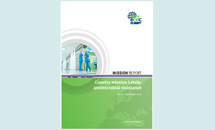ECDC country visit to Latvia to discuss antimicrobial resistance issues
Following an invitation by the Ministry of Health and as part of an ECDC country visit to Latvia on 26–30 September 2011, an ECDC team conducted visits and meetings to discuss AMR issues in Latvia and provide an assessment of the situation.
Compared with many other EU countries, the present AMR situation of Latvia is favourable. There is an infection control legislation that is under implementation and the legislation is a good basis for improving infection control practices in Latvian healthcare.
Executive summary
Rationale and purpose of the country visit
The Council Recommendation of 15 November 2001 on the prudent use of antimicrobial agents in human medicine (2002/77/EC)i outlines the threat that antimicrobial resistance (AMR) poses to human health and advocates for a range of actions to be taken for its prevention and control. Council conclusions on AMR of 10 June 2008 reiterated this call for action.
To assist Member States in implementing the Council Recommendation, ECDC developed a process for and is carrying out, upon invitation from national authorities, country visits to specifically discuss and assess the situation of the country regarding prevention and control of AMR through prudent use of antibiotics and infection control. These country visits also help document how Member States have approached this implementation and deployed national activities, and support the European Commission in evaluating this implementation.
This report, provided to the inviting national authority is the main output of the visit from the ECDC team. To help the ECDC team ensure consistency of the visits and follow-up of progress of countries, an assessment tool has been developed (see Annex 2). The assessment tool includes ten topics. These topics are regarded as core areas for successful prevention and control of AMR and are based on Council Recommendation 2002/77/EC and on Council Conclusions of 10 June 2008. The assessment tool is used as a guide for discussions during the visit.
Following an invitation by the Ministry of Health and as part of an ECDC country visit to Latvia on 26–30 September 2011, an ECDC team conducted visits and meetings to discuss AMR issues in Latvia.
Conclusions
Compared with many other EU countries, the present AMR situation of Latvia is favourable. In particular, Latvia has one of the lowest uses of antibiotics in the community (i.e. outside of hospitals) of all EU countries. There is an infection control legislation that is under implementation and the legislation is a good basis for improving infection control practices in Latvian healthcare.
However, looking at the trends of extended-spectrum beta-lactamase (ESBL)-producing Enterobacteriaceae, and of multidrug-resistant Acinetobacter baumannii in hospitals, as well as the high antibiotic use in hospitals, there should be a concern for more serious AMR problems in the future.
Latvia is now at a crossroads. If a good strategy to identify circulating AMR clones and a mechanism for their rapid containment is implemented, combined with reinforced infection control practices and a more prudent use of antibiotics in hospitals, Latvia could most probably postpone these problems.
Most of the knowledge of the Latvian situation on AMR derives from a few professionals and experts at Pauls Stradiņš University Hospital and is based on research projects and voluntary work. There are also dedicated professionals among the general practitioners that advocate for prudent use of antibiotics and proper treatment policies. These professionals and experts are valuable assets for Latvia. In Latvia, as observed in other EU Member States, dedicated professionals with a high level of expertise and experience are essential for surveillance, prevention and control in the specialised public health area of AMR.
The nature of AMR data as reported at EU level to The European Surveillance System/European Antimicrobial Resistance Surveillance Network (TESSy/EARS-Net) is different from that of other communicable diseases. Antimicrobial resistance data originate from routine clinical microbiology laboratories and include information on both antimicrobial-resistant and antimicrobial-susceptible isolates to determine the percentage of antimicrobialresistant isolates for multiple antimicrobials and several bacterial species. While it is, in principle, possible to perform some type of AMR surveillance with VISUMS (the computerised system for national surveillance and monitoring of infectious diseases) (e.g. for MRSA), VISUMS is not the most suited tool for collection of the broad range of AMR data from clinical microbiology laboratories as required by TESSy/EARS-Net.
Download




